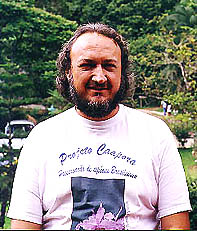

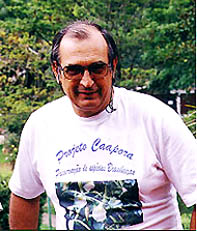

 |
 |
 |
| Artur Norberto Heger | José Carlos Cavalin |
The basic idea of the Caapora Project was born during the 1st. World Orchid Show which took place in São Paulo, in 1989. We had the first contact with foreign orchids growers and we noticed the great interest they had about Brazilian plants. Not only about the big stars like Cattleya labiata, purpurata, intermedia and so on but also about the plants which we call botanical, the small ones like Oncidium, for example.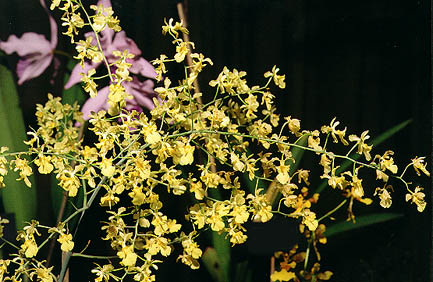 We also noticed the great difficult they had to bring those plants out of the country because they weren't produced by this time, almost every thing was collected in the nature. There was a big gap.
We also noticed the great difficult they had to bring those plants out of the country because they weren't produced by this time, almost every thing was collected in the nature. There was a big gap.
We were a big growers group of those plants in Brazil and every material we wanted, must be extracted from the nature. At this moment, we started to notice that it was a little bit serious question. If all those plants were being collected without reproduction, the moment the habitat disappeared, the plants would be at the risk of disappearing forever. This arose the idea of working, in some way, with it, to do something about. So we gathered a group of orchid growers and begin to think about the way of producing this kind of plants which weren't usually produced. By this time, the number of interested growers wasn't too big.
This arose the idea of working, in some way, with it, to do something about. So we gathered a group of orchid growers and begin to think about the way of producing this kind of plants which weren't usually produced. By this time, the number of interested growers wasn't too big.
What is exactly the Caapora Project?
Our big stars like Cattleya labiata, intermedia, Laelia purpurata, between others, are cultivated by so many people that they don't have the risk of disappearing because the best specimens are selected and reproduced in a large scale by orchids growers in Brazil and abroad. Any time we need those plants, for any reason, you will have thousands and thousands specimen spread around the world.
The purpose of Caapora Project is to reproduce and to preserve Brazilian orchids species which have less appeal for the growers and are, as a result, threatened of extinction. How would be the future of the plants which have smaller flowers, which don't attract so much attention like the Pleurothalidineas?  Or Sobralia and Stanhopea which flowers are big and attractive but they don't last for long time? Or those which flowers are very small regarding to their size, although numerous, like Oncidium, Epidendrum and some other genera? We work in order to produce this kind of plant and this has always been our central idea.
Or Sobralia and Stanhopea which flowers are big and attractive but they don't last for long time? Or those which flowers are very small regarding to their size, although numerous, like Oncidium, Epidendrum and some other genera? We work in order to produce this kind of plant and this has always been our central idea.
How did you choose this name, Caapora?
The moment we started this work, we were immediately concerned about the name. We concluded that, since the objective of the project was the preservation of Brazilian species, it would be correct to try to connect it to the most genuine thing we have, our indian mythology. So we took the Caapora myth from the tupi-guarani ( the Indian tribes of Brazilian) legends, Caa, in tupi-guarani means woods, herbs, plants, every thing related to vegetation and Pora is the protector, the defender. So, Caapora would be the woods protector.
However this term, as times go, suffered a transformation. As it was the woods protector and by the time it was fashion, correct taking things from the nature, destroying every thing, the Caipora appeared as an entity which impedes this. A bad guy who didn't allow taking plants from the wood. The myth was distorted and changed from guardian to aggressor because the correct was to take things from the nature. This is why, in some places in Brazil, when you talk about Caipora or Caapora, it is misunderstand as a bad thing, a person with evil intentions and so on, exactly because of its working of preservation. We looked for the original side of the legend which is the concept of preservation.
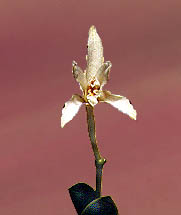 How was the beginning of this project?
How was the beginning of this project?
Our group started with 5 peoples but nowadays we are only 2 working seriously in this project: José Carlos Cavalin and myself. At the beginning, we tried to reproduce only the threatened Brazilian species but the Caapora project faced with a series of problems. When you work with the reproduction of the most known orchids, there is no secret about the cultivation media, germination mechanism and growth because all those questions have been widely studied and became well known. However when the question is to cultivate plants like Zygopetalineas, Pleurothalidineas, Oncidineas, there is no information available about the most adequate recipes for cultivation media, the best point of seeds maturation, in what degree they can be affected by the sterilization processes and so on ... Because of this lack of information, we lost many plants when we removed the plantlets from the flasks to the trays or nurseries and, besides, there is a little interest by the most part of the orchids growers for this kind of plant.
All those problems make the production very expensive, as a result any project exclusively directed for the production of those species, becomes impracticable .
What is the Caapora Project's philosophy ?
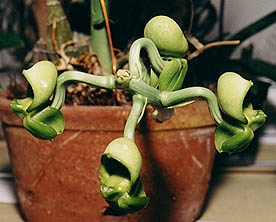 We think that way: Nowadays is utopia to talk about preserving plants exclusively in the nature. We see so many devastated areas, sometimes, we visit one to verify which plants grow there or to collect some and, if we return 2 or 3 years later, we can't find the place. The exuberant woods became a pasturage, a plantation, a farm, divided into lots or it is under a dam.
We think that way: Nowadays is utopia to talk about preserving plants exclusively in the nature. We see so many devastated areas, sometimes, we visit one to verify which plants grow there or to collect some and, if we return 2 or 3 years later, we can't find the place. The exuberant woods became a pasturage, a plantation, a farm, divided into lots or it is under a dam.
We found out that many plants we have knowledge by the older collectors mentions, don't exist any more. It occurs with some plants which existed inside São Paulo city, like the famous Cattleya velutina which occurred in the valley of Tramanduateí river, Pinheiros river's varzeas. There is no more varzeas at Pinheiros or Tramanduateí river. This is a plant which doesn't exist any more. Someone told it would have been found in valley of Paraiba river or some where else but if it really exists, we don't know.
Another example, 15 years ago, specimens of Scuticaria itirapinensis, collected in Itirapina mountains, São Carlos region, were regularly presented in orchids shows, but nowadays there is no report about it, not even about only one specimen. No one has this plant in cultivation. In other words, the plants have been collected and have been commercialized and,as it a very difficult plant to cultivate, no one was concerned about reproducing it. As a result, it is lost.
The habitat suffered successively fire and I know many peoples who have gone to Itirapina mountains to look for Scuticaria itirapinensis and, as far as I am concerned, they didn't find it.
In the same situation, there are many other plants. It is useless trying to preserve the plant in its habitat if this habit is not preserved.
Even so the habitat is preserved, how can we guarantee the survival of the species? It is not rare to find areas enough preserved where the orchids grow in a good quantity but, no matter how much you look for, you can't find a capsule of seeds. As orchids are very specialized plants, the pollination of certain species is done by only one pollinator agent. The non-existence of those capsules can be connected to the disappearing of this pollinator insect because of the use of insecticides in close plantation or, if it is a bird, it could definitively migrate to areas where the food is more abundant.
Without reproduction, any species could be wiped out. Those plants should be preserved in the botanical gardens but, unfortunately their structures are not the ideal. One or two peoples take care of the collections, when they retire or die, there will be a gap of many years before another person replaces them in this function.
How can this preservation project be a success ? What is its structure?
To be preserved, the plants should be put in hands of the greater possible number of peoples. How can we do this? We produce the plants and put them in the collectors' hands.
The collector who buys an orchid is, in principle, a person who loves that plant.
Does one know how to cultivate it?
I am not sure but some of the them will know and if we succeed in placing 500 specimens, many of them will die but some of them will be safe. However we have a problem. It is useless thinking only about producing those plants, give them back to he nature, distributing them among the collectors, the production of the plant takes a very long time and is expensive. We should do something self-sufficient.
How can it be done? Producing and selling.
In other words, you don't have any subsidy, the project depends just on you and the result you get with it? So, it is a personal project?
Exactly, we don't have any financial support. We have been working since 1990 when we started to establish and we are still investing money. But we do it in the proportion we can because we're, as I said, just 2 peoples working in the project. 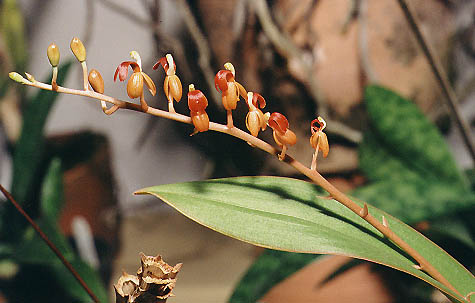 Of course, if we had a heavy structure, an important investment, we would be more advanced than we are nowadays. We work slowly. When you work with alive things, you can hurt to any kind of problem, at any moment. We know about nursery which disappeared because of , fire and so on... This is the reason that we prefer fungicides' problem to use our resources, if we have any problem. We will just lose our time and our work.
Of course, if we had a heavy structure, an important investment, we would be more advanced than we are nowadays. We work slowly. When you work with alive things, you can hurt to any kind of problem, at any moment. We know about nursery which disappeared because of , fire and so on... This is the reason that we prefer fungicides' problem to use our resources, if we have any problem. We will just lose our time and our work.
The production of those plants hurt to a problem: The Brazilian laboratories systems are turned to produce commercial plants, that is, you produce a capsule of Cattleya and sent it to the laboratory and there is a chance of 99% of this plant germinates and grows very well. You produce a Laelia purpurata capsule and is the same thing. 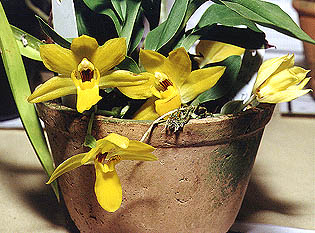 When you produce Pleurothallis, Oncidium, Bifrenaria, Promenaea, Zygopetalum capsules, the conditions required to cultivate those plants are different. If the needs of an adult plant is different, the needs of cultivating and germination in laboratory are also different. It requires more researches, more time invested and more wasting material, so producing a Pleurothallis is more expensive than producing a Cattleya. Cattleya has its place in the market, Pleurothallis doesn't.
When you produce Pleurothallis, Oncidium, Bifrenaria, Promenaea, Zygopetalum capsules, the conditions required to cultivate those plants are different. If the needs of an adult plant is different, the needs of cultivating and germination in laboratory are also different. It requires more researches, more time invested and more wasting material, so producing a Pleurothallis is more expensive than producing a Cattleya. Cattleya has its place in the market, Pleurothallis doesn't.
How could we solve this problem? Trying to find a way out to this difficult, we decided to produce, besides the most threatened Brazilian species, some of our big stars and foreign plants also threatened of extinction which are attractive to Brazilian market and some others which are not threatened but have a big commercial appeal.
With this parallel production, we are trying to support the production for preservation. We produce Cattleya at low cost and sell it at the usual price in order to subsidy Pleurothallis, Promenaea production which is more expensive and should be sold at low price or the market doesn't accept.
If a Pleurothallis is sold by R$ 15,00, we will be called crazy, we just can't do it. This problem is, we ask the laboratory to do 500 Pleurothallis and when the plants are adults, we will just get 30 or 40 specimens. That is, our cost of producing Pleurothallis is great, it is a hard work. We don't have any literature about, no references. At the laboratory, they don't know how to deal with those plants. 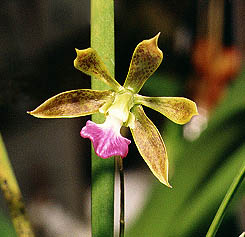 We have already had some big troubles with the production. We had more than 1.000 Coryanthes plants in flasks. We put them in the nursery, it worked very good, the plants grown well during 30 days, doubled their size, had a good development. During the winter, the temperature went down to 15o C, from the 1.000 plants lasted only 30 or 40. The following week, it went down to 14o C, there was nothing left, no plant alive. We know that Coryanthes doesn't resist to cool weather but 15oC, in principle, is not enough to decimate all of them but it decimated.
We have already had some big troubles with the production. We had more than 1.000 Coryanthes plants in flasks. We put them in the nursery, it worked very good, the plants grown well during 30 days, doubled their size, had a good development. During the winter, the temperature went down to 15o C, from the 1.000 plants lasted only 30 or 40. The following week, it went down to 14o C, there was nothing left, no plant alive. We know that Coryanthes doesn't resist to cool weather but 15oC, in principle, is not enough to decimate all of them but it decimated.
We don't have our own laboratory and it makes our project to be more expensive because this work must be done by someone else. When the plant leaves the laboratory, it has a cost, planted, another cost, how could we make good this loss?
We must produce more commercial plants but someone can say that we're not producing what we intend to do because we are also selling Cattleya trianae, loddigesii, labiata... Today someone asked about the production of foreign plants.
So this is the way you found to become this project possible?
Exactly, this is our way.
I can give an example, we sell 10 Comparetia speciosa which has big and attractive flowers and don't sell only one Comparetia coccinea, just for talking about the same genus.
And we didn't yet succeed in reproducing Comparetia coccinea, it is very complex.
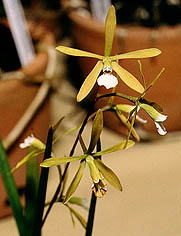 How do you work? Sowing, meristema or division?
How do you work? Sowing, meristema or division?
We just work with seeds. When you're working with a species, you hurt to another point: when the plant occurs in the nature, it occurs spontaneously, there is no natural seeking for genetic improving. We realized that the Brazilian species react very well to this genetic improvement. The same Purpuratas, Cattleyas labiatas which were very expensive 10, 15 years ago, nowadays are throw away, sold by R$ 10,00. Why? Because the growers have selected the best clones to cross in order to have a genetic improvement and succeeded in getting very attractive plants which have great commercial appeal, this pulled down the old famous plants. If we do the same thing with Oncidium, smaller plants, we will succeed in getting plants which will be distinguished and when we will succeed in having Encyclia's flowers with 3, 4 cm instead of 2 cm, the interest of market will be awaken. 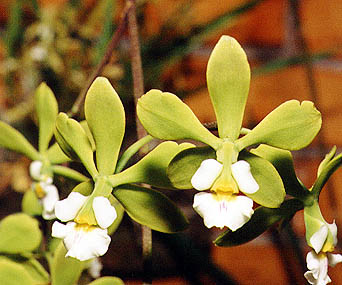 In my opinion, doing a meristema is to stop in the time because when you do it, you're considering that this form is the ideal and you stop exactly there, you don't obtain any improvement.
In my opinion, doing a meristema is to stop in the time because when you do it, you're considering that this form is the ideal and you stop exactly there, you don't obtain any improvement.
I think it is useful when we have a hybrid because when we produce it, we can do it 50 times, if just one of those hybrids is a spectacular thing, there is no way to have the same result again, we can't repeat it. In this case, you should do the meristema to have the same result. It is also useful when we have just only one specimen or an alba variety. This is a genetic deficiency and the plant in this case has much more difficult to reproduce, as it is more attractive to the market, it is interesting to reproduce it. The profit we get with the sale of the plants, could subsidy the production of the other plants.
As a matter of fact, we can't talk about genetic improvement with self-propagation, it doesn't exist. To look for a improvement, you should choose 2 good clones for crossing. Genetic improvement with the genetic back ground of only one plant, in my opinion, it is impossible. You can't improve just reproducing one plant.
We do a lot of thing by self-fecundation. If we have only one plant, the first step is to preserve it. Improving is necessary but if the only way we have is self-fecundation, it comes first. Next year, if we have two plants, we'll cross in order to try to improve them but when we have the threatened plant, the first step is to reproduce it.
There are some Brazilian plants which are so spread out, with so many different habitats, that it preservation can be done later.